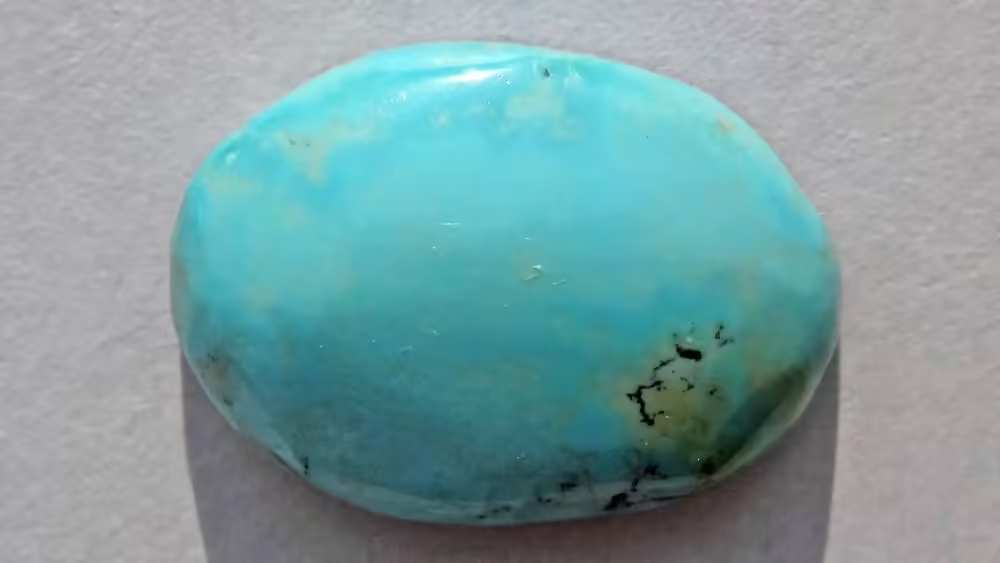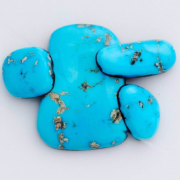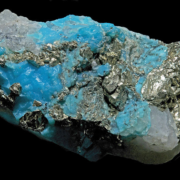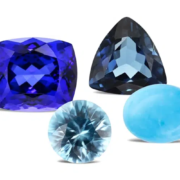Turquoise: Properties, Uses and Virtues
Turquoise: An heirloom gem!
Turquoise, an ancient heirloom gem, has been prized for its unique blue hue and spiritual associations for centuries. Its striking color, reminiscent of skies and oceans, has captured the imagination of cultures the world over. Delve into the geological origins, historical uses and metaphysical attributes that make Turquoise a gem of enduring appeal.

Turquoise: Table of contents
- Turquoise Geological Formation
- Rough Turquoise – Raw Beauty Revealed
- Sources – Turquoise’s Global Reach
- Historical Significance of Turquoise – Through the Ages
- Metaphysical Properties of Turquoise – Illuminating energies
- Turquoise Varieties
- Turquoise Colors
- Durability and Wearability of Turquoise
- Turquoise Enhancements – Preserving Natural Beauty
- Synthetic Turquoise – Nature in Laboratory
- Imitations of Turquoise – Discerning the Authentic
- Turquoise Care – Preserving natural beauty
Turquoise Geological Formation
Turquoise is a hydrated phosphate mineral formed by complex geological processes involving the presence of water and minerals such as copper. Often found in arid regions, Turquoise can form in host rocks through the percolation of mineral-rich water, creating the captivating blue hues that define this gem.
Rough Turquoise – Raw Beauty Revealed
Turquoise has no crystalline form, so there is no defined raw crystal. On the other hand, it can be found in the form of rocks or pieces of rock. The unique patterns, veins and matrix formations within the stone contribute to its individual charm.
Sources – Turquoise’s Global Reach
Turquoise is mined in various parts of the world, including the American Southwest, Iran, China and more. Each region contributes to the diversity of Turquoise’s colors and characteristics, making it a gem appreciated worldwide.
Historical Significance of Turquoise – Through the Ages
Turquoise, an ancient gemstone, has a rich history and symbolism across cultures. The rulers of ancient Egypt adorned themselves with turquoise jewelry, while Chinese craftsmen carved it over 3,000 years ago. Tibet considers turquoise its national gem, believing it to guarantee health, fortune and protection from evil.
Derived from the French expression “pierre tourques”, meaning “Turkish stone”, the gem’s name arrived in Europe from Turkish sources in the 13th century.
Among the Native American tribes of the American Southwest, turquoise had ceremonial significance and was used in jewelry and amulets. The Apaches associated it with precision, attaching it to bows and firearms.
From bead sizes to sculptures, turquoise comes in many different dimensions. Its popularity varies, but remains strong in the American Southwest, captivating those drawn by the region’s charm and blue skies.
Turquoise is one of December’s birthstones, alongside zircon.
Metaphysical Properties of Turquoise – Illuminating energies
Turquoise is believed to possess metaphysical properties that facilitate communication, self-expression and spiritual harmonization. It is considered a stone of protection, fostering a deep connection to intuition and encouraging a sense of inner calm. Turquoise is also associated with the throat chakra, encouraging honest communication and self-awareness.
Turquoise Varieties
Turquoise has a wide range of blue hues, from delicate sky blue to deep green, often with complex matrix patterns formed by inclusions in the host rock. Although there are no distinct varieties of Turquoise, its unique appearances make each stone a one-of-a-kind treasure.
Turquoise Colors
Turquoise’s color spectrum ranges from light, delicate blues to rich, vibrant greens evocative of tropical waters. These shades evoke a sense of calm and tranquility, reflecting the gem’s connection to nature and spirituality.
Turquoise is generally opaque, but a rare Virginia variety shows transparency to translucency.
Durability and Wearability of Turquoise
With a Mohs scale hardness of 5 to 6, Turquoise requires careful handling and protective cuts and mounts to avoid scratches or damage. Despite its moderate hardness, Turquoise remains a prized gem for jewelry and artistic creations. Proper care ensures its lasting elegance and appeal.
Turquoise Enhancements – Preserving Natural Beauty
Stabilization is a common treatment to strengthen porous Turquoise, making it more suitable for jewelry while preserving its inherent color and matrix. The process involves infusing wax or resin under pressure to fill the cracks. This treatment is long-lasting and can be repeated if necessary, although the resin tends to yellow with age.
Pieces of Turquoise can be pressed together with resin to create a new composite stone.
Synthetic Turquoise – Nature in Laboratory
According to the strict definition of synthetics, Synthetic Turquoise either exists or it does not. As a general rule, it’s not possible to recreate a mineral like turquoise, however, Gilson created a simulator/synthetic very close to the real stone and is today considered synthetic.
Imitations of Turquoise – Discerning the Authentic
Turquoise’s popularity has led to the creation of imitations. It’s important to be aware of potential imitations, such as tinted stones, especially tinted Howlite, which is widely used on the market to deceive buyers. Tinted magnesite can also be used as a simulant, as can variscite, glass, ceramic, resin or plastic.
Unfortunately, these simulants can be difficult to differentiate for a novice.
It’s worth noting that “turquoise” as a color is also very popular, and many sellers will knowingly or unknowingly call their jewelry “turquoise” in reference to the color and not the stone. This can be very confusing for buyers. As a general rule, it’s best to acquire specimens and jewelry from reputable sellers.
Turquoise Care – Preserving natural beauty
Careful handling of Turquoise jewelry ensures its timeless beauty.
Avoid exposing Turquoise to harsh chemicals, mechanical cleaning, direct sunlight or rapid temperature changes.
Clean the stone gently with a soft brush and a little soapy water, and protect it from shocks to avoid chipping or scratching.
Avoid contact with oils and hot water, which can stain the stone due to its porosity.
Wearing perfume or body oil with a turquoise necklace can be detrimental to the stone.
To preserve its radiance, Turquoise can be gently oiled or waxed, if desired.





Leave a Reply
Want to join the discussion?Feel free to contribute!